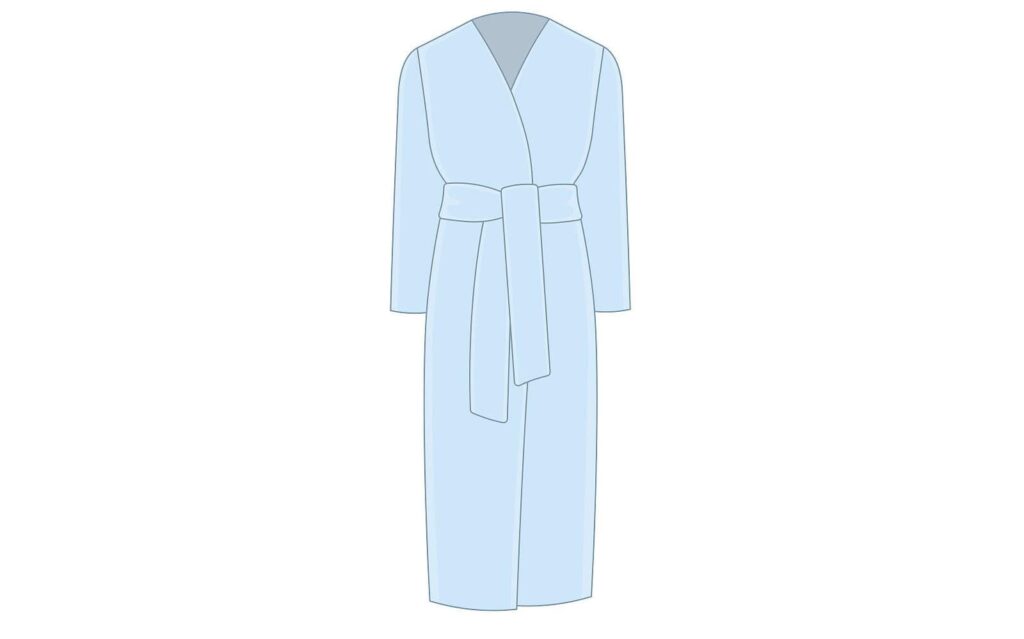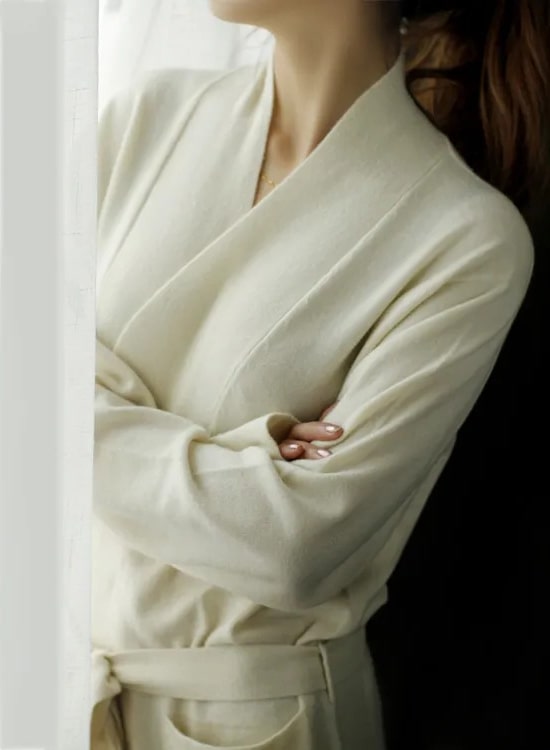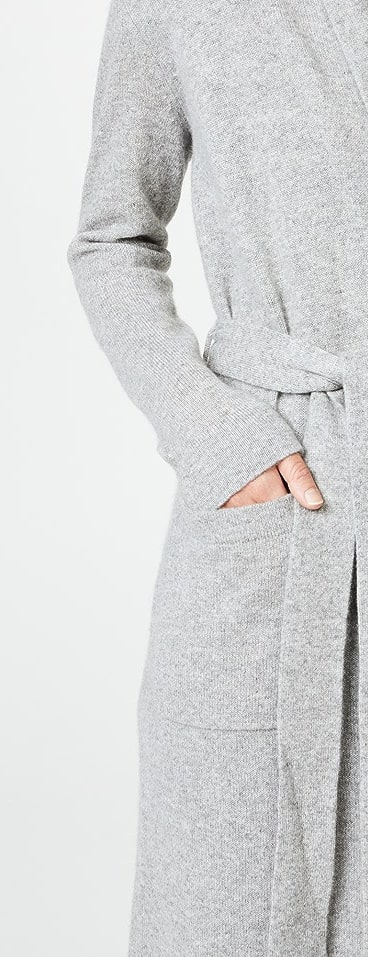In the realm of high-end loungewear, cashmere robes occupy a preeminent position. They offer unparalleled comfort, coupled with exceptional thermal properties, despite their lightness, due to the unique structure of cashmere fibres.
These fibres, finer and softer than conventional wool, provide warmth without the excess weight or bulk associated with other materials. This makes cashmere robes an optimal choice for warmth and comfort, particularly in colder climates or seasons.
Besides the physical comfort, a cashmere robe brings a certain level of versatility. It serves as an excellent lounging garment, suitable for post-bath use or as an additional layer over nightwear for enhanced warmth. Their versatility extends to various settings, from a relaxed home environment to luxury spa experiences, underpinning their broad appeal.
The durability of cashmere, when adequately maintained, should be highlighted. A well-cared-for cashmere robe can retain its appearance and feel for years, underpinning its value as a lasting investment rather than a simple purchase.

The emotional and psychological satisfaction derived from owning and wearing a cashmere robe should not be overlooked too. The robe’s inherent luxury contributes to a sense of well-being, enhancing the wearer’s everyday experience by adding a touch of indulgence.
In a world increasingly populated by synthetic fabrics, cashmere’s natural appeal persists. Cashmere robes continue to represent timeless quality, marrying tradition and luxury in a way few other items can. They are more than just a garment; they represent an amalgamation of comfort, sophistication, and a commitment to enduring quality. They are an experience.
What makes a cashmere robe special?

Cashmere robes are unique and luxurious garments, thanks to their distinctive set of characteristics. These characteristics originate from the exquisite nature of cashmere, which lends the robes their unmistakable qualities of warmth, comfort, durability, versatility, and style.
The materials and texture of cashmere robes are what sets them apart from their counterparts. Cashmere itself is derived from the undercoat of cashmere goats, which produce a fine, soft fibre. When woven into fabric, it creates a material that is not only incredibly soft and light, but also surprisingly warm. This softness translates into a tactile experience unlike any other, providing a texture that is plush, comforting, and exudes luxury.
The warmth and comfort provided by a cashmere robe are truly remarkable. Despite its lightweight nature, cashmere has excellent insulation properties, which is why cashmere goats are able to survive in the harsh, cold climates of their native habitats. The dense weave of the cashmere fibre traps air effectively, creating a thermal barrier that retains body heat. This means that despite being lightweight, a cashmere robe can provide superior warmth and comfort.
Durability is another key characteristic of cashmere robes. While cashmere might seem delicate, it’s incredibly resilient when cared for properly. Despite its fine texture, it’s a robust and enduring fabric that resists pilling and retains its shape over time. This means that a cashmere robe can be a long-lasting investment, providing luxury and comfort for years.
When it comes to versatility and style, cashmere robes truly shine. The natural elegance of the material lends itself to a wide range of styles, from classic to contemporary. This allows cashmere robes to seamlessly blend with any personal style or home decor. Moreover, they can be worn in a variety of contexts, be it a cosy evening at home or a relaxed morning routine, making them a versatile addition to any wardrobe.
Types of Cashmere Robes
Cashmere robes, much like the individuals who enjoy them, come in a myriad of styles and configurations, catering to diverse preferences and needs. This variety is apparent in the distinctions concerning length, design, and gender-specific options.
Length: The choice of robe length predominantly depends on personal preference and practical use, and it significantly impacts the comfort and aesthetic appeal of the robe.
- Full-length: Full-length cashmere robes extend to the ankles, providing comprehensive warmth and coverage. They are particularly appreciated in colder climates or for those seeking a more traditional, elegant appearance.
- Knee-length: Knee-length cashmere robes strike a balance between coverage and freedom of movement, making them a popular choice. They are particularly suitable for activities that require more agility, such as morning routines or leisurely strolls.
- Short: Short cashmere robes, often reaching mid-thigh, offer the most mobility and are favored for their casual, contemporary appeal. Despite their shorter length, the insulating properties of cashmere ensure they still provide ample warmth.
Design: The design of a cashmere robe encompasses its overall style and aesthetic, including aspects like the cut, collar, belt, and detailing.
- Traditional design: Traditional cashmere robes often feature a shawl collar, patch pockets, and a tie belt, paying homage to the classic bathrobe design. They may also feature more conservative, neutral colors and patterns.
- Modern design: Modern designs of cashmere robes, on the other hand, might experiment with elements such as kimono collars, contrasting trims, bold colors, or minimalist patterns. These designs resonate with individuals seeking a contemporary, chic edge.
Gender: While the luxurious comfort of cashmere transcends gender, there are designs specifically tailored to men’s and women’s preferences, body shapes, and sizes.
- Men’s cashmere robes: These are typically more structured, featuring broader shoulders and lengths that lean towards full or knee-length. The color palette may also be more restrained, with neutral or darker shades being more prevalent.
- Women’s cashmere robes: Women’s cashmere robes often showcase more tailored fits, accentuating the feminine form. They also exhibit a wider range of lengths, colors, and patterns, offering a greater variety of stylistic choices.
In essence, the diversity in cashmere robes allows for a personalized approach to luxury and comfort. Whether one prefers a full-length traditional robe for its classic elegance or a short, modern design for its stylish practicality, there’s a cashmere robe designed to meet these expectations. The inclusion of gender-specific designs further enhances the bespoke nature of cashmere robes, underlining their appeal as a personalized luxury garment.
How to choose the perfect cashmere robe?

Selecting the perfect cashmere robe requires careful consideration of several key factors that influence both the comfort and aesthetic appeal of the garment. Each variable plays a crucial role in optimizing the wearer’s experience and ensuring the robe meets their specific needs and preferences.
Size and Fit: The size and fit of the cashmere robe significantly affect comfort and overall appeal. An appropriate size ensures that the robe provides adequate coverage and warmth, while the right fit enhances the wearer’s mobility and appearance. Measurements such as the wearer’s height, shoulder width, and waist size are typically used to select the correct size. It’s also important to note that some individuals may prefer a looser fit for a more relaxed feel, while others may prefer a more tailored fit for a streamlined silhouette.
Quality and Thickness of Cashmere: The quality of the cashmere fibre is critical to the robe’s durability, warmth, and softness. High-quality cashmere is characterized by long, thin fibres, which result in a denser, softer, and warmer fabric. On the other hand, the thickness of the cashmere determines the robe’s weight and warmth. Robes made of thicker cashmere provide superior warmth and are typically more durable, although they may also be heavier.
Pricing Considerations: The price of a cashmere robe reflects factors such as the quality of the cashmere, the complexity of the design, and the brand’s reputation. Higher quality cashmere and more intricate designs typically command higher prices. However, it’s important to consider the robe as an investment in long-term comfort and style. While a high-quality cashmere robe may have a higher initial cost, its durability and timeless appeal often provide excellent value over time.
Style and Color Preferences: The style and color of the robe should reflect the wearer’s personal aesthetic. Whether they prefer a traditional or modern design, a vibrant or subdued color, these preferences help to personalize the robe. The style influences the robe’s overall look and feel, while the color can complement the wearer’s complexion and coordinate with their existing wardrobe. This personalization enhances the robe’s appeal, making it not just a garment but an expression of personal style.
In summary, choosing the perfect cashmere robe involves a balance of practical considerations and personal preferences. By taking into account factors such as size, fit, cashmere quality, price, style, and color, individuals can find a robe that offers optimal comfort, style, and value.
How to care for your cashmere robe?
Proper care for your cashmere robe is crucial to maintain its quality, appearance, and longevity. It involves specific procedures for cleaning, storing, and maintaining the robe, each of which is designed to preserve the integrity of the cashmere fibres and ensure the robe remains a luxurious addition to your wardrobe for years to come.
Washing Instructions: Cashmere requires careful handling during cleaning to prevent damage to the fibres. It is typically recommended to hand wash cashmere robes in cold water using a gentle, cashmere-safe detergent. The garment should be soaked for a few minutes, gently agitated, and then rinsed thoroughly. Avoid wringing or twisting the robe as this can distort its shape and damage the fibres. Instead, press out excess water and dry the robe flat on a towel, reshaping it as necessary. For convenience, some high-quality cashmere robes can be machine washed on a delicate cycle with a low spin speed, but always check the garment’s care label first.
Storage Tips: Proper storage of your cashmere robe helps protect it from damage such as pilling, stretching, and moth infestations. Cashmere robes should be stored flat, in a cool, dry place, ideally wrapped in tissue paper or a breathable fabric bag. If hanging is necessary, use a padded hanger to prevent stretching. Before storing your cashmere robe for an extended period, ensure it is clean to deter moths and other pests.
Repairing and Maintaining Cashmere Robes: Despite its durability, cashmere can occasionally develop minor issues such as pilling or small holes. Pilling can often be remedied with a cashmere comb or similar device, gently removing the pills without damaging the fabric. Small holes or tears can usually be repaired by a professional, preserving the life of your robe. Regular maintenance, such as de-pilling and professional cleaning, can significantly extend the lifespan of your cashmere robe and keep it looking its best.
In essence, the care and maintenance of a cashmere robe require a little extra effort but pay off in terms of the garment’s extended lifespan and continued luxury. By following the appropriate washing and storage guidelines and addressing minor repairs promptly, you can ensure that your cashmere robe remains a cherished part of your wardrobe for years to come.
Top brands and suppliers of cashmere robes
The market for cashmere robes is characterized by a select group of renowned cashmere brands and suppliers, each noted for their exceptional quality, design innovation, and commitment to sustainable practices. These entities have solidified their reputation through years of delivering products that consistently meet or exceed customer expectations.
Brand Recognition: Brand reputation is often a reliable indicator of quality, customer service, and product design. Brands such as Loro Piana, Brunello Cucinelli, and The White Company are well-known for their high-quality cashmere products, including robes. These brands, among others, have built their reputation on the superior quality of their cashmere, their craftsmanship, and their sophisticated, timeless designs.
Product Quality: Suppliers renowned for their cashmere robes often source their cashmere from specific regions known for the finest quality cashmere, such as Inner Mongolia. This ensures the quality of the raw material, which is then crafted into robes through meticulous processes that maintain the integrity of the cashmere while creating a luxurious, comfortable garment.
Sustainable Practices: Many top brands and suppliers are committed to sustainable and ethical practices. This includes sourcing cashmere responsibly, treating the cashmere goats humanely, and maintaining fair working conditions for those involved in the production process. Brands such as Naadam and Patagonia are well-known for their commitment to sustainable cashmere production.
Innovation and Design: Brands that lead in innovation and design, such as N.Peal and MaisonCashmere, offer a wide range of styles, colors, and fits, ensuring a variety of options for discerning customers. Their designs strike a balance between timeless appeal and contemporary trends, ensuring their cashmere robes remain stylish, versatile, and relevant.
It’s important to note that while brand recognition and reputation can guide consumers towards quality products, personal preference concerning style, fit, and feel ultimately dictates the best choice. A brand’s commitment to quality, sustainability, and design innovation will, however, ensure that the investment in a cashmere robe is one that provides lasting comfort, style, and satisfaction.
Environmental and Ethical Considerations
In the contemporary era, the purchase of luxury items like cashmere robes is increasingly influenced not only by factors such as quality and design but also by environmental and ethical considerations. It’s essential to understand the sustainability of cashmere production, animal welfare issues, and the ethics of sourcing cashmere when making an informed purchasing decision.
Sustainable Cashmere Production: The sustainability of cashmere production hinges on practices that minimize environmental impact and ensure the longevity of cashmere resources. Unsustainable grazing practices can lead to land degradation and desertification, compromising the future supply of cashmere. Therefore, responsible brands invest in sustainable farming practices, such as rotational grazing, to preserve the grassland ecosystem. They also adopt eco-friendly processing methods to minimize water and energy use, as well as chemical pollution.
Animal Welfare Issues: Cashmere is harvested from cashmere goats, and their treatment is a significant ethical concern. Inhumane practices can lead to distress and poor health among the animals. Ethical cashmere producers ensure that they source their fibre from farms where goats are treated humanely. This includes providing adequate food and shelter, ensuring proper veterinary care, and using gentle, stress-free shearing practices.
Ethical Sourcing of Cashmere: Ethical sourcing extends beyond the treatment of cashmere goats to include fair treatment of the people involved in cashmere production. This involves ensuring fair wages, safe working conditions, and an absence of child or forced labour in the harvesting and processing of cashmere. Brands committed to ethical sourcing often engage in direct trade relationships, invest in local communities, and seek certifications that validate their fair trade practices.
In essence, environmental and ethical considerations are increasingly important in the realm of cashmere robes. By supporting brands and suppliers committed to sustainable production, animal welfare, and ethical sourcing, consumers can contribute to a more responsible and sustainable luxury garment industry.
Final thoughts
To summarize this comprehensive exploration into the realm of cashmere robes, we have touched upon various aspects, from the core characteristics and types of cashmere robes, to how to select the perfect robe and care for it to ensure longevity. We delved into the top brands in the market and highlighted the environmental and ethical considerations involved in the production of cashmere robes.
In conclusion, investing in a cashmere robe is not just about indulging in a luxury garment; it’s about appreciating the craftsmanship, sustainability, and ethical standards that go into making the robe. It’s about choosing a piece that aligns with your personal style and values, and that will provide lasting comfort and satisfaction. In essence, a cashmere robe is more than a garment; it’s a testament to quality, comfort, and conscientious consumerism.
FAQ
Does the thickness of the cashmere robe equate to its quality?
Not necessarily. Quality is determined more by the length and fineness of the cashmere fibers, not the thickness of the garment. However, a thicker robe may provide more warmth, but it may also be heavier.
What causes pilling in cashmere robes, and how can it be avoided?
Pilling is caused by friction that leads the cashmere fibers to tangle into small balls. To minimize pilling, avoid excessive rubbing during wear and follow proper washing and storage instructions.
Can I hang my cashmere robe in the closet?
It’s recommended to store cashmere robes flat to maintain their shape. If hanging is necessary, use a padded hanger to avoid stretching.
Why is there such a price disparity among cashmere robes from different brands?
The price of a cashmere robe reflects several factors, including the quality of cashmere, the complexity of the design, and the reputation of the brand. Higher quality cashmere and more intricate designs typically command higher prices.
Can cashmere robes be dyed into different colors without losing their softness?
Yes, cashmere fibers can be dyed into a variety of colors without compromising their softness, as long as the dyeing process is done carefully and correctly.
Are there any certifications I should look for to ensure I’m buying a sustainable and ethically produced cashmere robe?
Certifications such as the Global Organic Textile Standard (GOTS), Fair Trade, and Responsible Wool Standard (RWS) can indicate sustainable and ethically produced cashmere garments.
Can cashmere robes be worn throughout the year, or are they strictly winter garments?
Although cashmere is renowned for its warmth, it is also highly breathable, making it comfortable for year-round wear. The comfort level also depends on the thickness of the robe and personal preference.
Does wearing a cashmere robe require any specific undergarments?
No specific undergarments are required for wearing a cashmere robe. However, soft, breathable fabrics are generally recommended for optimal comfort.
